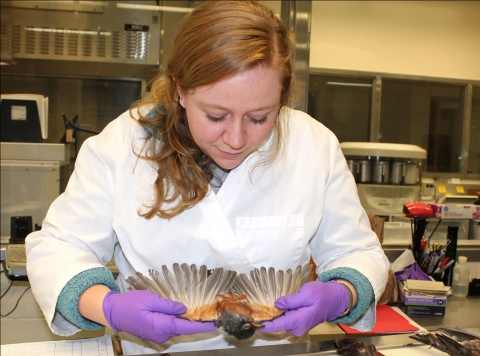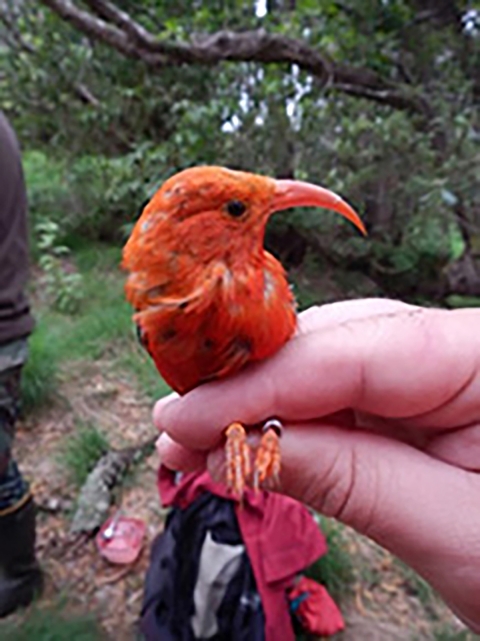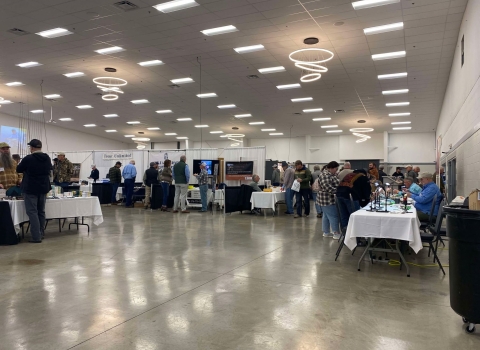"It was difficult for me to find female role models doing what I wanted to do. What I didn’t know, until I started working at the Lab, was that there were pioneering women in the field of forensic ornithology. The field started in the 1960’s with Roxie Laybourne, who worked at the Smithsonian in Washington, DC. She helped investigators determine that a flock of European starlings was to blame for a fatal plane crash," Forensic Scientist Ariel Gaffney.
The National Fish and Wildlife Forensic Laboratory (Lab) is much like a “typical” police lab complete with forensic scientists who work with law enforcement on criminal investigations by analyzing evidence to support investigations. However, unlike most “police labs,” the Service's Lab goes much further. There is a wide array of forensic scientists that deal with morphology, genetics, and pathology who support the OLE in the field to facilitate the legal wildlife trade as well as examine, identify, and compare evidence and provide expert testimony during investigations and court proceedings.
Her Primary Focus of Work
One such forensic scientist is Ariel Gaffney – Morphology. However, “Forensic Ornithology” might be the better term to describe Ariel’s work at the Lab because her work is paramount in helping the Service’s wildlife inspectors and special agents identify bird bones, feathers, and crafted items made with bird parts and whole birds, both alive and dead. When one thinks of how many types of birds, ducks, grouse, emus, and peafowl (to name some of the birds of the world), it’s an impressive feat to be able to identify the birds not only by their full body, but by feathers as well.
What was your career path that brought you to the Service?
I have an undergraduate and master’s degree in biology with an emphasis on birds, although I studied white-faced capuchin monkeys in Costa Rica and coral reef ecology in Belize. However, my passion is birds.
Ariel Gaffney holding an ‘I’iwi, an endemic honeycreeper of Hawaii. As part of her research with USGS, Ariel was capturing, checking health, monitoring for avian diseases, banding the birds, and releasing them back to the wild. Credit: USFWS
In 2013, I started working for the U.S. Geological Survey (USGS) in Hawaii at the Pacific Island Ecosystems Research Center researching avian pox, avian malaria, and knemidocoptic mange. I had the opportunity to helicopter into remote areas of the Big Island so we could catch, sample, and treat native birds infected with this type of mange. I also got to process the field samples at the USGS lab to examine the rate of avian malaria infections.
Toward the end of my master’s degree at the University of New Mexico, I met Dr. Pepper Trail, the Lab’s senior forensic scientist, at the North American Ornithological Conference. I never knew this field existed. I was debating whether I would go on to pursue my PhD, but after hearing what a forensic ornithologist does, I wanted to do that.
I went from studying hummingbird physiology and behavior to morphological identification of feathers and bird parts - it was a bit of a shift. However, during my field research with USGS and through my education, I learned how to use morphological differences to determine the age and sex of live birds, which has proven very useful for my identifications work here at the Lab. This position has given me the opportunity to combine my knowledge of bird morphology and taxonomy with my desire to be a part of an applied science.
Why do you believe your job makes a positive difference?
There are biologists who work on the study of wildlife and their habitats, there are law enforcement officers that investigate crimes, and my position as a forensic ornithologist allows me to bridge the gap between both worlds. Our team at the OLE works to facilitate the legal trade and help stop the illegal trade, and I get to play a small, but important part in that. My identifications let our agents and inspectors know whether the feather they are looking at is a legal turkey feather or one from an endangered species. Assisting the Service’s law enforcement officers, and occasionally other investigators worldwide, is a role not everyone can play and I feel very privileged to be a part of the team that does.
What else do you enjoy about your job?
I enjoy teaching and helping the agents and wildlife inspectors expand their “toolbox” to include bird identifications, which allows them to make quick and confident judgement calls on wildlife and products they see.
I also really enjoy being in a capacity to still do research. There is a freedom to ask questions in this position, “How can we improve this method? Can we compile a short and concise list of characters that our agents and inspectors could use in the field?” Although I’m not in academia, I’m still involved in peer-reviewed research and it has practical and immediate uses. Wildlife forensics is still such a young field, so anything we can do to further the research in this area is exciting.
What advice would you give to a young woman who is thinking about pursuing a career like yours?
Ornithology has traditionally been a male dominated field, but I would say, over the last decade or so, there has been an increase in females. If you look at many of the senior scientists in ornithology though, it’s still a very male dominated and was difficult for me to find female role models doing what I wanted to do. I feel like I should mention that the professors I worked with in undergrad and grad school were extremely supportive and really valued having a diverse group of students to which they mentored.
What I didn’t know, until I started working at the Lab, was that there were pioneering women in the field of forensic ornithology. The field started in the 1960’s with Roxie Laybourne, who worked at the Smithsonian in Washington, DC. She helped investigators determine that a flock of European starlings was to blame for a fatal plane crash. Roxie went on to train and mentor other brilliant women including Dr. Carla Dove, who became a program manager for the National Museum of Natural History’s Feather Identification Lab; Marcy Heacker, also at the Smithsonian Feather Lab; and Beth Ann Sabo, who joined and began building the reference collection at the Service’s Lab.
What I love about the job…
I love that we, the scientists at the Lab, also get to work with our counterparts in other countries. I’ve met with scientists from the Philippines, Mexico, and countries in South America and Africa. Our lab has become a resource for countries beginning their own wildlife forensic laboratories. For example, we walk them through how we perform casework, our protocol documents, and the handling and storage of evidence. In addition, I get the opportunity to learn about the wildlife trade and law enforcement in other countries.
The Lab’s Feather Atlas is also something else I love that I have had the chance to collaborate on. I love that it is used by not only law enforcement as a resource, but also by everyday people and kids to help them identify the feathers they find in their backyards. Yearly, we have over a million hits on the website and we keep increasing the number of birds - we currently have up to 426 species represented on the atlas.
Future Endeavors
I’m looking forward to traveling again and having the opportunity to spend some time at the Smithsonian Feather Lab learning more from Dr. Dove about techniques such as microscopy. If you have a small white feather, how can you tell if it came from a duck, a raptor, or a turkey? If you examine the feather under a microscope, you can see there are microscopic structures that are unique to each of these groups… Another tool for my toolbox!
- Interviewed and written by Special Agent Kathy Spengler, OLE Comms Team





